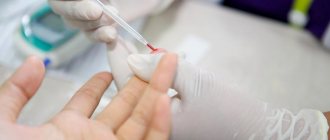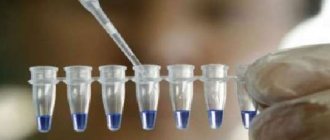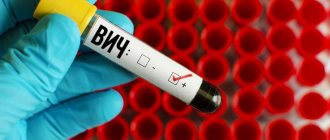About HIV
In the photo, a health worker is drawing blood, since HIV is a blood infection and the presence of the virus can only be determined in it.
Immunodeficiency syndrome is caused by a virus that attacks white blood cells. Penetrating into a cell, it inserts its DNA section into the genetic code of the cell and changes its program. In the presence of an immunodeficiency virus, the cell does not perform its function, but copies a fragment of the parasite's genome. Stopping the work of these cells can cause the development of other infectious diseases, since the immune system ceases to perform a protective function.
What is ELISA
ELISA – enzyme-linked immunosorbent assay. The purpose of the ELISA method is to detect antibodies to the immunodeficiency virus in biological material. Using the method, you can track the presence in the liquid not of the viruses themselves, but only of the antibodies produced in response to their presence. Enzyme immunoassay is widely used in the diagnosis of STDs. It helps detect HIV and other sexually transmitted infections.
There are several types of ELISA: direct version, indirect version, sandwich method. In any case, the technique is based on determining the presence of antibodies, which serve as an indicator of the penetration of a foreign agent. To identify these “tags,” the biological component is treated with enzymes.
Enzyme immunoassay determines antibodies with an accuracy of 96–98%, the error is insignificant. It is 2 – 4%.
Preparing for the correct test
You can take an HIV test at any nearest medical center. The test can be taken upon referral or at will if infection is suspected. Pregnant women are required to undergo tests to prevent intrauterine infection. When testing for HIV, blood is analyzed, so preparation for the test is the same as for a regular blood test and includes the following points:
- A few days before the test, you should not drink alcohol;
- Do not eat fatty, salty or sweet foods for several hours.
- Tea without sugar is allowed;
An unreliable test result may be affected by:
- Smoking;
- Bad feeling;
- Severe stress;
- Serious physical activity the day before.
Often people seek to conduct an anonymous analysis at home. Such tests maintain confidentiality, but have a low threshold of reliability.
How to pass the test correctly
In order to get a reliable result, on the day of the procedure you must give up alcoholic beverages, smoking and fatty foods. The test must be taken in specialized clinics and laboratories. You cannot bring blood for analysis with you (with the wording - a friend asked, he could not come).
After donating blood, you can return to your normal lifestyle.
How to take the test yourself
Recently, the presence or absence of HIV can be determined at home if a person is embarrassed to donate blood to a laboratory. For this purpose, express tests are sold in pharmacies. The reliability of such tests is low and varies significantly among different developers. However, if the result is positive, the citizen is obliged to inform the attending physician and undergo an examination. Concealing a diagnosis is a criminal offense.
Pharmacies sell rapid tests, based on which you can determine your preliminary diagnosis. In addition to the test, you can understand that you are sick by other signs, such as lymphopathy, rash, and so on
Negative plus
The result can be positive, negative or doubtful. In the latter case, it is worth retaking the analysis a little later.
Article on the topic
"I'm not dangerous." A young mother spoke about life with HIV infection
Doctors say that if the result is positive, it is impossible to immediately declare that a person has HIV or AIDS. Indeed, in some cases, indicators may be overestimated for other reasons. In this situation, you should retake the test again - everyone who has a “+” result goes through this procedure.
Where does the “false signal” come from? Due to certain diseases and conditions that may cause cross-reactions. For example, due to allergies, antigens that are incomprehensible to the body can be produced in the blood, which it recognizes as foreign.
Also, a similar reaction can occur due to a sharp change in blood composition - for example, due to a jump in cholesterol (with excessive consumption of fatty foods, fried foods, seeds), hormonal imbalance (in particular, during menstruation in women), infections (respiratory diseases, the presence of hepatitis and influenza viruses, recent vaccinations, tuberculosis), excessive blood thickness, arthritis, oncology. Fungi, viruses and bacteria can also contribute to the appearance of incorrect data. In addition, a false positive result can occur due to medical errors: violation of the rules for collecting and transporting blood, use of low-quality serum, and improper storage of the material.
Reasons that may result from an incorrect HIV test
HIV testing is carried out constantly in our country. Almost every citizen has undergone this examination several times for one reason or another. However, cases of erroneous results are still common.
The causes of such errors may be:
- Other diseases in the body that stimulate the formation of the same proteins;
- Improper preparation of the patient for the examination;
- Stressful situations that can provoke a decline in a person’s immunity;
- Poor quality reagents in the laboratory;
- Error in labeling of blood samples.
To ensure that the error does not become fatal, the analysis result is rechecked in case of a positive or questionable result.
If a person suffers from diseases that can cause a test error, then this is checked with a more accurate test.
A repeat test is scheduled after a week.
Advice! In order for the test to be as accurate as possible, it is worth preparing for the HIV test, taking into account all the recommendations.
What is the incubation period and how is it determined
After the virus enters the body, it does not appear at first. The virus adapts to the host. The first signs of the disease appear only after a few weeks and even months. This period is called incubation. Since the parasite is inactive, the production of human antibodies does not occur. For this reason, the disease can only be detected during this period using an ultrasensitive method.
Once the virus leaves this stage, it can be detected with a simpler marker.
Important! The incubation period for HIV can be repeated several times, so periodically an HIV test may be negative or inconclusive. It is important not to stop treatment after such data. There was no final recovery!
Medicines prescribed for HIV keep the virus in an incubation state. During this period, it does not harm the immune system. The body can fully defend itself against any infection that penetrates it.
If treatment is stopped, after a month the virus will enter the active phase and a sharp deterioration in well-being will begin.
Enzyme-linked immunosorbent assay (ELISA) in the diagnosis of HIV infection
The most common method for diagnosing HIV infection is enzyme-linked immunosorbent assay (ELISA) , which detects antibodies to HIV in the patient’s blood serum.
Antibodies to the virus appear in 90-95% of infected individuals 4-6 weeks after infection, in 5-10% after 3-6 months, and in 0.5-1% at a later date. In this regard, the period from the moment of infection until the appearance in the blood of quantities of antibodies to HIV determined using generally accepted laboratory diagnostic methods is called the “seronegative window”. During this time, it is impossible to make a diagnosis, but such a person can be a source of infection and infect other people.
Enzyme-linked immunosorbent assay (ELISA) allows you to detect the total spectrum of antibodies to the structural proteins of HIV in the blood. If the test serum or plasma gives a double positive result in the ELISA, it is tested in a confirmatory immunoblot test (stage II). Unlike ELISA, immunoblot allows the detection of antibodies to individual viral proteins. Based on the immunoblot results, a final diagnosis of HIV infection is made.
This assay uses two types of reactions: immunological and enzymatic.
All ELISA variations are based on the ability of antibodies to specifically interact only with “self” antigens, i.e. on the immunological antigen-antibody reaction.
The most widespread is the heterogeneous version of the enzyme immunoassay, in which the antigen (the compound being determined) or antibodies are fixed on a solid base, which can be a polystyrene tablet, polystyrene beads, a porous substrate or a magnetic carrier. The analysis is carried out in 3 stages. The biological material being studied—the patient’s blood serum—is added to the well of the tablet, which contains one or another antigen on its walls (i.e., one of the proteins of the virus). If there is an infectious agent in the body, antibodies to it appear in the serum. They bind tightly to the antigen and are not removed during subsequent washing of the dish.
At the next stage, it is necessary to determine whether or not an immune complex has formed in the well, that is, whether the antigen has combined with the antibody. This cannot be seen with the naked eye or under a microscope, so the following two stages are required, which can be called developing.
At the second stage of the analysis, special antibodies (reactive with different antibodies) with an enzyme pre-attached to them are added to the well (therefore the method is called enzymatic). An “antibody-enzyme” fused into a single complex (conjugate) is capable of contacting antibodies that have already latched onto the antigen, which is attached to a solid support. The result is a “molecular chain” with a viral protein at one end and an enzyme at the other. After washing, this entire multilayer “pie” remains in the well of the tablet. Now you need to detect enzyme activity in order to conclude the presence of an antibody. To do this, at the third stage, a solution of the substrate and a special colorless substance - chromogen, which is capable of coloring as a result of a series of biochemical reactions carried out by the enzyme present in the well, is added to the same well. If color appears in the hole, this means that all elements of the chain are present. The conclusion follows from this: the patient’s blood contains antibodies to HIV antigens and, therefore, the patient himself is infected with this virus.
There are other variants of the ELISA method. For example, it is possible to detect not antibodies, but the antigen itself. The procedure will be generally similar, although a little more complex.
Test results may be positive, negative or inconclusive.
If the result is negative and there is no suspicion of recent (within the last 6 months) infection, the diagnosis of HIV can be considered unconfirmed. If there is a suspicion of recent infection, a repeat examination is carried out.
ELISA can give both false negative and false positive results.
A false negative ELISA result is possible with a fresh infection, while antibodies to HIV have not yet been produced by the patient’s body.
False-positive results can be obtained when examining patients with chronic diseases and in some other cases:
- An administrative error in a clinic or laboratory (for example, a mix-up in the labeling of specimens or forms) can result in incorrect results being reported to individuals undergoing HIV testing. Therefore, it is recommended that all patients with a positive reaction to the presence of antibodies to HIV take another blood sample and test it for antibodies to HIV using the same method.
- The most common cause of a false positive test is vaccination. However, one case of such a result has been described in systemic lupus erythematosus and end-stage renal disease.
Therefore, when a positive ELISA result is obtained, it must be rechecked using more sensitive methods.
Laboratory research
It is very important to get tested at the moment the virus begins to be detected; usually 3+ months must pass from the moment of infection.
HIV is determined in two main ways:
- ELISA test;
- Immunoblotting.
In the first case, research is carried out using the polymerase chain reaction method. The essence of the method is that a certain protein is isolated, copied several times and identified. This method will not help identify the disease while the virus is in the incubation period and the protein has not yet been produced.
The second laboratory diagnosis of HIV is based on the detection of response proteins in the human body. Detection of antibodies to HIV is considered a more accurate way to determine the disease than the polymerase chain reaction method.
There is a third method - enzyme immunoassay. It is based on identifying both the virus and the antibody at once. Due to its high cost, it is used less frequently than the ELISA test.
About normal result
Norm - what does it mean? When the HIV test is negative, this is considered normal.
1. The latest generation of ELISA test systems allows you to determine the presence of antibodies to HIV and protein particles. If the analysis is normal, then no antibodies or protein particles of the pathogen are found in the blood. But it is possible to say for sure that a person is healthy based on this if there was no risk of infection for 3 months before the test. Otherwise, after some time, you need to repeat the tests.
There have been cases where HIV was discovered only after 6 months. Therefore, if the result is negative, and there was contact with an HIV-infected patient, for reliability it is necessary to repeat the tests after three, four and six months. It happens that the ELISA gives a negative result, but a person clearly suspects the presence of signs of HIV, then it is recommended to take the test again. An erroneous result is possible due to the early timing of the analysis or due to the human factor.
2. If the result is negative using immunoblotting, then this is currently the most reliable analysis.
If a person has the immunodeficiency virus, and the result is negative, then most likely this is a medical error, which can occur at any stage of the test. If, when repeating the immunoblot after three and six months, the result is negative, then there is nothing to worry about, this indicates the norm. And only after a negative immunoblot response will a certificate be issued stating that the HIV test is negative.
3. PCR testing in adults is used extremely rarely when diagnosing the immunodeficiency virus, and this method is used for newly born children.
A negative result is also considered the norm here.
4. According to sociological research, many people use rapid HIV testing. When they see a negative line, people calm down and refuse to go to a medical facility, even if they have all the signs of HIV infection. But you need to know that the accuracy of the rapid test is eighty-five percent. In addition, at home you can carry it out incorrectly, or the storage conditions will be violated. There is an even greater chance that the result is incorrect. Even drinking mineral alkaline water 8 hours before testing will affect the test result. Therefore, the fact that a person does not have the immunodeficiency virus based on a rapid test, even if it is negative, is not always a true statement.
HIV test result options
There are several options for recording results after analysis:
- Negative result;
- False negative;
- Positive;
- False positive;
- Doubtful or uncertain.
With each of the verdicts received, you should contact your doctor, who will explain the data or prescribe a repeat analysis.
Positive analysis
If the analysis results in a verdict - the test is positive, most likely the patient has this disease. A person has the right, even if the result is reliable, to be tested for HIV again if he has doubts about the correctness of the blood draw. This can be done in the same or another laboratory. Repeated analysis may require a fee.
Questionable analysis
If a questionable result is obtained, a repeat analysis is mandatory. First, the doctor finds out the reasons for such data by talking with the patient. A questionable result can be obtained if the patient is not properly prepared or if the blood sample is taken incorrectly. In this case, if the value of the analysis does not change, not a repeated analysis is carried out, but another form of analysis.
Requests for help Write your story I have a questionable test for HIV. My boyfriend left me. I’m waiting for the result of a repeat test. If it’s positive, I don’t see any point in living. How can I die? Support the site:
nobody, age: 28/09/21/2012
Responses:
Hello. I understand how you feel, because for a similar reason I came to this site in the fall of 2010. Since then, my life has changed dramatically. For the better. Thank God for everything! What my head and will could not do, God's tests helped me do. Now I’m already writing responses. Dear girl! Firstly, doubtful does not mean 100 percent. Even if there is something like that, believe me, you come to terms with it and it’s not so scary. Read stories of people with similar experiences. They give birth to children and live like everyone else. Everything is in God's will and your courage. You have to live. Because for all of us, life on this earth is temporary. The fate of the soul is more important. There is no point in suicide simply because the soul goes to hell. And suffering, more terrible ones, is just beginning. For patience with sorrows, the Lord has a reward here. Believe me, by God's will everything can change. Including your tests. Pray with all your heart and what will be will be. All the will of God. We all have time in this life for good, time to benefit our soul. Appreciate him. With God we can overcome all trials. Right now you are in shock, but this too will pass. Live, girl. Need to live. It may sound corny, but everything will really be fine. If you don’t give up with God, all the events in life go to our benefit and salvation.
Sergey K, age: 29/09/21/2012
Why die?! Do you even know the statistics of HIV infections over several years? And they live, enjoy life. What if the test turns out to be negative? Well, the guy... that means your boyfriend loved you so much. In my opinion, a real man would never do that.
Alexander, age: 27/09/21/2012
Relax, because the analysis has not yet been confirmed! Even if the test is positive, you shouldn’t give up right away. Life goes on! The meaning of life is in life itself and in unconditional love for it under any circumstances. Every person has problems: someone is sick, someone suffers mentally. This is life - a series of lessons that make us strong. A person who has HIV is NOTHING worse than people who do not have it, he is just the way he is. You just need to accept yourself and love yourself. There are many kind, wonderful people around who are ready to help in difficult times. Don’t be offended by the world, don’t close yourself off from others. You must live to be happy and give happiness to others. Everything is yours, you create your own destiny.
Zlata, age: 16/09/21/2012
Nobody, baby. People are not Gods. Although the Gods make mistakes... The tests need to be retaken in another clinic. My friend, a mother of three children, received positive tests for syphilis twice. you should have seen this respectable woman, she was crying so much... Not understanding where and how. After a month of running around, surveys and searches, it turned out that she was given the results of a namesake (!) This is the reality. Doctors are getting tired. nurses confuse boxes and folders, cones and test tubes, bottles and so on... so CALM. All over again. And then we'll talk again. Pray to Saint Panteleimon. He is excellent at healing any wounds!
O.P. , age: 49 / 09/21/2012
Hello! What does “how to die” mean? Even if there is HIV, then every day of life will be worth its weight in platinum. Life itself is a short thing. It seems like you just recently went to school, but you’re already working. It flies by unnoticed. Therefore, in this case, you need to, on the contrary, appreciate every day even more. You don’t see the meaning of life, but it is there, and it’s quite specific: the salvation of the soul, or in other words, unity and eternal bliss with God. There is physical death, but there is no spiritual death. God created people not for a short life and endurance of sorrows, but for eternal bliss. The trouble is that people have violated the Divine world order. But with faith in God Jesus Christ, there is no point in fearing death: the one who strives for Him, living according to His Commandments, will be saved. Therefore, especially, in no case should you kill yourself. In addition, it is not yet a fact that an HIV test will confirm it. Know that nothing happens by chance in life. There must be an explanation for this. Very often we suffer because of our sins, but there is also providential suffering, which ultimately leads to even greater spiritual growth. But all this suffering encourages people to correct their lives and, ultimately, to save their souls. If you do not believe in God, then you can at least admit the possibility of the existence of God and faith in Him. Fortunately, there is a lot of material on this subject. And if you believe, then even more so, ask Him to deliver you from death, ask Him to give you strength to survive these trials. And most importantly, do not be afraid of death and prepare for it by repenting and correcting your life according to the Commandments. In the Orthodox Church there is Confession - the Sacrament of Repentance. There is no death, but suicide is the path to hell. DON'T GIVE UP, DON'T DESPAIR AND GOD WILL HELP YOU!!!
Anthony, age: 24/09/21/2012
How to die? - Wait until old age. You won’t look back when you get close. Correct yourself and live according to your conscience, as you should.
kamchatka, age: 19/21/09/2012
I understand you. I myself had an affair with an HIV+ girl due to stupidity and drunkenness. Naturally, I did not know about her status in advance. Protected himself with a condom. However... there was unprotected oral contact. a week later mononucleosis and symptoms are as expected. And now health problems continue. I understand how difficult it is!
Convoy, age: 28/12/26/2012
Previous request Next request Return to the beginning of the section
| print version |
Analysis transcript
In the laboratory, patients are given a transcript of the analysis containing a large number of values and numbers. The further process of deciphering the analysis results can only be done by a doctor. The patient is given the final result in the form of an inscription or stamp on a form; the patient is either HIV-positive or HIV-negative, or the analysis is questionable.
A professional laboratory will give you clear results that make it clear immediately whether you have become infected with HIV or not
About normal result
Hospital patients should not be afraid when a doctor orders an HIV test. This data is necessary in a number of cases:
- Before surgery;
- When donating donor blood;
- During pregnancy or planning it;
- When applying for some positions.
There are no special indications for prescribing this analysis. Diagnosing HIV is a standard procedure that you should not be afraid of.
Advice! Doctors recommend taking an HIV test once a year, even in the absence of questionable sexual contact. It is impossible to take into account all routes of infection with this disease.
HIV diagnostic methods
In Russia, a standard procedure is carried out to diagnose HIV infection, which includes two levels:
- ELISA test system (screening analysis);
- immunoblotting (IB).
Other methods can also be used for diagnosis:
- PCR;
- rapid tests.
About the indicators after the study using the polymerase chain reaction method
PCR analysis is carried out to determine the foreign protein. To take an HIV test using the PCR method, there must be certain indications, since the UVA method is cheaper. This method is considered more sensitive.
For doctors, the tests look like a set of data, like in a photo, from which they need to understand whether there is an infection or not. Most often, the transcript is given by laboratory assistants, since not all doctors are really prepared for this type of information about the analysis
What to do if you test positive
After the examination, in case of a positive result, the patient often falls into panic and depression. This should not be done, as this condition will not help solve the problem.
It is important to understand that there can be two options for this result:
- Error in data (for a number of reasons);
- Presence of illness.
The first case can be excluded by repeating the analysis. If the diagnosis is confirmed, then it is necessary to begin treatment. With the modern level of medical development, the lifestyle of an HIV-positive person changes slightly.
False positive analysis, reasons
In case of a false positive result for HIV, a repeat examination is prescribed. A common reason for this result is poor-quality reagents, sample contamination, and similar reasons.
False positive result in pregnant women
Pregnant women are required to be tested for HIV. When a woman gives birth to a new life, a hormonal shift occurs. For this reason, many blood parameters and the functioning of various systems may change. In order to take into account all the nuances of the body’s condition, when taking blood for analysis, it is determined how much time has passed since conception. The data of such analysis is verified using a special table. The result may be false positive if the doctor incorrectly calculated the timing of pregnancy.
False positive result in pregnant women
It is widely known that during pregnancy, an HIV test can give incorrect results. This is due to the fact that serious hormonal changes occur in the body of a pregnant woman. At the same time, the immune system of the expectant mother is also involved in vigorous activity.
Why ESR is lower than normal - an overview of the reasons
A spectrum of various antibodies is produced. Many of them are very important for the baby’s health, as they penetrate the placental barrier and provide the child with immunity in the first months of life. But these antibodies can very easily interact with reagents in HIV testing systems.
How to eliminate the possibility of obtaining a false result from blood tests
It is impossible to completely eliminate the possibility of an error when testing blood for HIV, but you can significantly reduce the risk of getting one.
To do this, you need to follow several rules:
- Do not drink alcohol several days before the test;
- Do not eat fatty, salty or sweet foods for several hours.
- You can drink tea without sugar;
- Observe hygiene rules in the laboratory;
- Employees of the medical institution must collect the test according to the instruction card.
It is important to know the routes of infection in order to check your results in time.
To avoid becoming a hostage to a false positive analysis
An ELISA test must be performed after questionable contact after 6-12 weeks. During this period, human immunodeficiency virus antibodies are detected. In this case, a false positive analysis can be excluded by 70%.
Before donating blood for HIV (ELISA), you must not break your diet, drink alcohol, drugs, and not be sexually active at least 2-3 weeks before taking an HIV test. Blood is donated only on an empty stomach. How much blood the doctor will take, how much the test costs, as well as the expiration date of the test can be found directly at the medical center. If you have existing viral or infectious diseases, it is better not to take the test; you must contact the laboratory 35-40 days after recovery. If you have other chronic diseases, you should inform your doctor.
Even if the test turns out to be positive, there is no need to panic; it may be a false positive. How many months should pass after the first delivery?
After 3-4 months, the ELISA test can be retaken. In a person whose blood does not contain the immunodeficiency virus, the result is guaranteed to be negative.
Many people are interested in the question of how long does HIV live? The human immunodeficiency virus, when exposed to air, dies almost instantly. It dies at temperatures above 40°C. Therefore, if it were possible to warm a person’s blood to such a temperature, HIV would be defeated, and as many people would not die as are currently dying from the virus.
Other possible medical mistakes
It is important that when collecting any hazardous material, the doctor is reliably protected.
Otherwise, it may become a source of infection. In any medical institution there is a job description for medical workers. It contains a sequence of actions for AIDS to prevent its spread.
Any office in which biological fluids are manipulated must be equipped with a special disinfectant solution and ultraviolet lamps to prevent the spread of the disease.
If a false diagnosis was received, the error may be due to improper handling of laboratory equipment:
- The device was not washed after the previous analysis;
- Incorrect analysis parameters have been specified, etc.
If a medical error is discovered, the patient has the right to moral compensation. Doctors are obliged to detect the error in time and order a re-examination. In addition, they must ensure that the patient is not infected with HIV during medical procedures.








